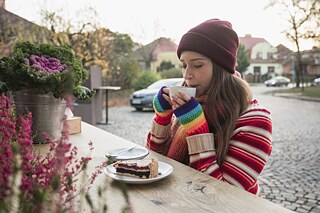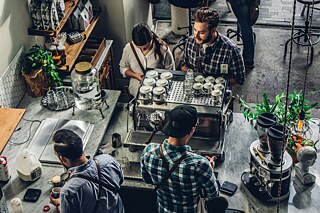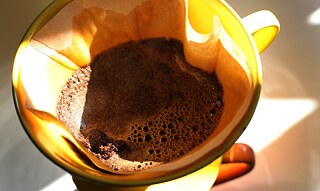German coffee culture
Fancy coffee and cake?

There's nothing like a coffee in good company with a delicious piece of cake. The Germans even have their own word for it: Kaffeeklatsch. Get your cups out, we present five specialities of German coffee culture.
ENOUGH STRESS, CARPE DIEM!
Coffee is the Germans' favourite drink, ahead of beer and mineral water. What's more, the otherwise rather stressed people in this country take plenty of time for their favourite drink. Sipping an espresso while standing and quickly glancing at the newspaper, as is common in Italy or France, is something that is rarely done here. The combination of coffee and a small treat reminds Germans that it's good to savour things. Is that why the kitchen wall tattoos with the words “Carpe diem” are particularly popular with them?
A moment of pleasure with coffee and cake | Photo (detail): © mauritius images / Westend61 / Ok Shu
FROM A LUXURY GOOD TO A PICK-ME-UP FOR EVERYONE
The first coffee house opened its doors in the harbour city of Bremen in 1673. Hamburg and other cities soon followed suit. At that time, coffee was still a luxury item, especially for aristocrats and wealthy citizens. This changed as more and more coffee became available due to the expansion of trade routes. And there were coffee substitutes such as malt coffee for the less well-off. In the 1950s, coffee was roasted industrially for the first time, allowing even larger quantities to be sold at lower prices. In 1965, the statistics said: Germans like nothing better than coffee. And while a few centuries ago it was mainly high-status women who met for coffee gossip, today the picture is completely diverse: from senior citizens to the clique in front of the neighbourhood kiosk to young people in trendy cafés – everyone loves coffee gossip.
A thirst for coffee in the trendy café | Photo (detail): © joshua-rodriguez-f7zm5TDOi4g
THE COMEBACK OF FILTER COFFEE
And how is coffee drunk in Germany? Many households and cafés have invested in high-quality fully automatic machines or portafilter machines in recent years. Coffee that flows out of these machines is often decorated with latte art to top it all off. However, tried and tested trends can also be found on café drinks menus: In addition to the "pot of coffee" with lots of coffee cream, there is iced coffee for the warmer days: vanilla ice cream, whipped cream and syrup add calories to cold coffee. But classic filter coffee, flavoured and often prepared by hand, is also becoming popular again with German coffee lovers.
A favourite drink again: filter coffee | Photo (Detail): © picture alliance / dpa | Karl-Josef Hildenbrand
ANYTHING ELSE TO GO WITH IT?
Always delicious, always nutritious: pastries with coffee are celebrated in Germany. Crumble cake, cheesecake or Black Forest gateau: the list of delicacies is long. Almost everyone loves them, and all these beautiful cakes are a welcome gift to bring along to coffee mornings. A favourite treat in almost all hipster cafés is vegan banana bread – it's easy to bake:3 ripe bananas
100 ml unflavoured oil
100 ml vanilla soya milk (or other plant-based milk)
225 g flour
150 g sugar
1 tsp vanilla sugar
2 tsp baking powder
1 pinch of salt
1 tbsp cornflour
Place the chopped bananas, oil and vanilla soya milk in a mixing bowl and mix together. Add the flour, sugar, baking powder, cornflour and salt and mix well. Pour the batter into a loaf tin (23-25 cm long) and bake in a preheated oven at 180 degrees top/bottom heat for 60 minutes.

Ideal combination: homemade banana bread and coffee | Photo (Detail): © mauritius images / Elena Veselova / Alamy / Alamy Stock Photos
FAIR IS THE TREND
When people drink coffee in Germany, the beans are often sourced from fair trade – this is the trade in agricultural products, where small farmers receive a reliable minimum wage that secures their livelihood. . And minimum social and ecological standards are observed overall. Although there is still a lot of room for improvement compared to sales of conventional coffee, coffee has been the number one fair trade food in Germany for several years now. A trend that is entirely in line with human rights and sustainability! Topped off with a – fair trade – cappuccino and a chocolate cake, the cocoa for which also comes from fair trade cultivation, of course.
Coffee cherries from Fairtrade cultivation in Peru, coffee farmer at work | Photo (detail): © mauritius images / Jutta Ulmer